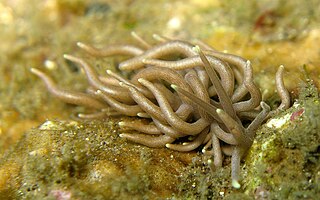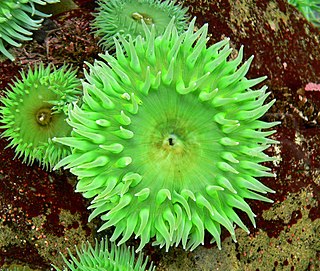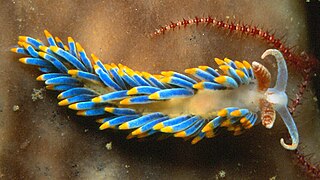
Aeolidiidae, a family of aeolid nudibranchs, are a family of sea slugs, shell-less marine gastropod molluscs.

Aeolidia papillosa, known as the common grey sea slug, is a species of nudibranch in the family Aeolidiidae.

The purple lady nudibranch, Paraflabellina funeka, is a species of aeolid nudibranch, and is a very colourful sea slug. It is a marine gastropod mollusc in the family Flabellinidae.

Trinchesia speciosa, common name the "candy nudibranch", is a species of sea slug, an aeolid nudibranch, a marine gastropod mollusc in the family Trinchesiidae.

Phyllodesmium is a genus of predatory sea slugs, aeolid nudibranchs, marine gastropod molluscs in the family Facelinidae.

Anthopleura xanthogrammica, or the giant green anemone, is a species of intertidal sea anemone of the family Actiniidae.

Aeolidia is a genus of sea slugs, aeolid nudibranchs, marine gastropod mollusks in the family Aeolidiidae.

Berghia is a genus of sea slugs, aeolid nudibranchs. They are shell-less marine gastropod molluscs in the family Aeolidiidae. They are covered in cerata which give them their unique tentacle look and color. Berghia are commonly found in shallow waters and their diet consists of strictly Aiptasia Anemone. This genus is now commonly used commercially to fight off Anemone populations in fish tanks.

Cerberilla is a genus of sea slugs, aeolid nudibranchs, shell-less marine gastropod mollusks in the family Aeolidiidae.
Anteaeolidiella saldanhensis, is a species of sea slug, an aeolid nudibranch. It is a shell-less marine gastropod mollusc in the family Aeolidiidae.
Anteaeolidiella ireneae is a species of sea slugs, an aeolid nudibranch. It is a marine gastropod mollusc in the family Aeolidiidae.
Anteaeolidiella poshitra, is a species of sea slugs, an aeolid nudibranch. It is a marine gastropod mollusc in the family Aeolidiidae.

Anteaeolidiella oliviae, is a species of sea slug, an aeolid nudibranch. It is a marine gastropod mollusc in the family Aeolidiidae.

Berghia stephanieae is a species of sea slug, an aeolid nudibranch. It is a marine gastropod mollusc in the family Aeolidiidae. It was previously known as Aeolidiella stephanieae.

Spurilla neapolitana, the Neapolitan spurilla, is a species of sea slug, an aeolid nudibranch, a marine gastropod mollusk in the family Aeolidiidae. It is native to the western Atlantic Ocean, the Caribbean Sea and the Mediterranean Sea. This species was first described as Eolis neapolitana by the Italian naturalist Stefano delle Chiaje in 1841. However, although some authorities quote the year as 1823, the species does not appear in the first volume of delle Chiaje's memoirs, which was published that year. The species was later reassigned to the genus Spurilla.
Baeolidia gracilis is a species of sea slugs, an aeolid nudibranch. It is a marine gastropod mollusc in the family Aeolidiidae found in the Philippines.
Baeolidia lunaris is a species of sea slug, an aeolid nudibranch. It is a marine gastropod mollusc in the family Aeolidiidae found in Tanzania.

Aeolidiella alderi is a species of sea slug, an aeolid nudibranch in the family Aeolidiidae. It is native to northwestern Europe where it occurs in the intertidal zone. It is a predator and feeds on sea anemones.

Aeolidia filomenae is a species of sea slugs, an aeolid nudibranch, a marine gastropod mollusc in the family Aeolidiidae. Previously confused with Aeolidia papillosa, this species occurs on coasts of the NE Atlantic Ocean from Scotland south to Portugal.
Baeolidia rieae is a species of sea slug, an aeolid nudibranch. It is a marine gastropod mollusc in the family Aeolidiidae.














